High-Performance Bronze Worm Gears
Experience the Strength of Self-lubricating Bearings
CuAl11Ni worm gear reducers, Elevate Your Machinery with Premium Bronze Worm Gears
This material, also known as aluminum bronze, is characterized by its high strength and excellent wear resistance, which are crucial properties for gears that operate under high loads and at low to moderate speeds. Experience unmatched durability and precision with our CuAl11Ni bronze worm gears. Perfect for reducers. Boost efficiency now!
Key Properties of CuAl11Ni, 2.0981:
Composition: Primarily composed of copper (Cu) with significant aluminum (Al) and nickel (Ni) content. The designation “11” typically suggests around 11% aluminum, with nickel usually being around 5-6%.
Hardness and Wear Resistance: The presence of aluminum and nickel enhances the hardness and durability of the bronze, making it resistant to wear and galling.
Corrosion Resistance: Aluminum bronzes like CuAl11Ni are highly resistant to corrosion, including seawater and many acidic environments, which makes them suitable for various industrial applications.
Machinability: While not as easy to machine as some other bronzes, CuAl11Ni can still be machined with the right tools and techniques.
Applications:
Worm gears in worm gear reducers due to their ability to withstand high loads and provide a smooth transmission of motion with minimal wear.
High-load bearings and bushings, where durability and resistance to deformation are critical.
Marine hardware, where corrosion resistance is particularly valuable.
If you need further information or specific details about using CuAl11Ni in manufacturing or its mechanical properties, let me know!
GB-CuAl11Ni, specified in DIN 17656-1983, is a type of aluminum bronze widely acclaimed for its mechanical prowess in the production of worm gears, bearings, and bushings. Here’s an extensive look into its attributes and uses:
Alloy Composition and Properties
GB-CuAl11Ni consists predominantly of:
- Copper (Cu): 72.0-78.0%
- Aluminum (Al): 10.0-12.0%
- Nickel (Ni): 4.0-7.5%
- Iron (Fe): 4.0-7.0%
- Manganese (Mn): 0.8-1.5%
- Trace elements: Including tin (Sn), zinc (Zn), silicon (Si), lead (Pb), antimony (Sb), phosphorus (P), and sulfur (S).
Key Properties
- High Strength: Exhibits robust tensile and yield strength, ideal for applications under heavy stress.
- Wear Resistance: Exceptional durability against wear, crucial for components like worm gears enduring significant friction.
- Corrosion Resistance: Demonstrates good resistance to corrosion, particularly beneficial in marine environments, owing to its aluminum and nickel content.
- Good Machinability: Despite its strength, the alloy is machinable, enabling precise component manufacturing.
- Low Thermal Conductivity: While beneficial for some applications, its low thermal conductivity may require consideration in heat-intensive uses.
Applications
Worm Gears
GB-CuAl11Ni is highly prized for worm gear applications due to its combined strength, wear, and corrosion resistance. It finds utility in:
- Gearboxes
- Pumps
- Valves
- Conveyors
- Robotics
- Textile and mining machinery
Bearings and Bushings
The alloy’s self-lubricating properties and durability make it ideal for manufacturing bearings and bushings, essential in environments with high loads and corrosion challenges.
Manufacturing Techniques
Casting
Components are typically cast using:
- Centrifugal Casting: Ensures uniform material properties, ideal for precise items such as worm gears.
- Sand Casting and Continuous Casting: Employed based on specific component requirements.
Machining
Post-casting, machining is utilized to achieve precise dimensions and surface finishes, leveraging the alloy’s machinability for cost-effective production of complex parts.
Summary
GB-CuAl11Ni, per DIN 17656-1983, stands out as a robust aluminum bronze alloy suitable for worm gears, bearings, and bushings. Its strength, wear, and corrosion resistance make it invaluable across diverse industries, despite considerations of cost and thermal conductivity. By harnessing its properties, industries can enhance the efficiency and longevity of mechanical components, ensuring reliable performance in challenging operational settings.



